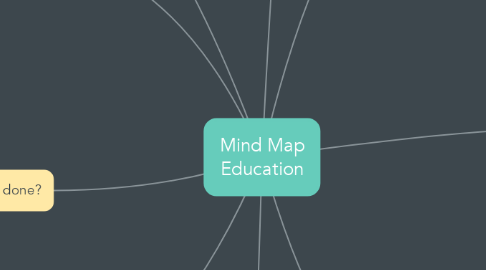Mind Map Education
Door Guillermo Méndez Terán


1. .What is being done?
1.1. The government is starting a capacitation for rural teachers in Querétaro.
1.2. Querétaro (and other states) have an annual event called “Foro de Consulta Educativa Estatal” where people can propose solutions to education problems. In 2018 there were over 600 different propositions.
1.3. In the next month Queretaro will invest over 12.5 millions in educational infrastructure.
1.4. In September of last year it was created the National Commission to Continuously Improve education (Comisión Nacional para la Mejora Continua de la Educación) with the objective of generating and publishing research that will help professors to develop professionally and students to improve their learning.
2. What has been done?
2.1. In México:According to UNESCO statistics, tertiary enrollments in Mexico have more than doubled, going from 1.9 million to 4.4 million between 2000 and 2017.
2.2. In the world: The visualization presents estimates of world literacy for the period 1800-2014. Literacy rates grew constantly but rather slowly until the beginning of the twentieth century. And the rate of growth really climbed after the middle of the 20th century, when the expansion of basic education became a global priority.
3. What will be done?
3.1. The new educational reform of AMLO raises 5 important changes for education in the following years: 1) It contemplates the repeal of the Law of the National Institute for the Evaluation of Education (INEE). 2) the repeal of the Professional Teaching Service Law. 3) The permanence of teachers in their positions will not be determined by the results they have in the tests that are made to them. 4) It is also important to note that the promotion of teachers to new positions will also not be linked to any evaluation. 5) Principles of free, secular and compulsory education, those of universality, equity and excellence, for all levels, including university.
4. What about?..
4.1. NGO: Among other things, NGOs are a source of expertise in the education sector. Since NGOs are ran by people with professional skills and specialized people on board, they can use this capacity empower the sector. In some cases, NGOs establish colleges for teacher and other personnel that work in schools.
4.2. Governmment: AMLO has vowed to accommodate the surging demand for education by building 100 new universities, eliminating university entrance examinations, and allowing “every person access to higher education.”
4.3. Corporations: Tertiary-educated workers in Mexico enjoy the second highest earnings over those with upper secondary education among OECD countries. The share of young adults without upper secondary education has fallen, but pathways from secondary to tertiary education remain limited.
5. What about technology?
5.1. Educational technology is about the use of technological devices for educational uses, currently, the staff of educational centers has the possibility of acquiring internet, computers, digital whiteboards, mobile phones and tablets to share their knowledge or organize classes and tasks. The technology brought with it the possibility of studying online, which simplifies access to education in terms of place and time, finding information is much simpler and you can access huge databases quickly.
6. The first and the last thing about it.
6.1. Mexico is 30 points below of OCD countries of people who graduate from secondary school.
6.2. In México the government doesn't spend more than 4 dollars per person in their whole education
6.3. Mexico has the double amount of students in public schools than in private schools
6.4. Most young children attend primary school but only 62 percent reach secondary school. At secondary level about half of students drop out and only a quarter reach higher education
6.5. Mexicans read less than three books a year on average, a product of low education levels and poverty
7. What does the problem look like?
7.1. Querétaro is the 2nd place in secondary school but in elementary is 25th.
7.2. Of the 37 countries that are members of OCDE, mexico is the country with the highest percentage of people that repeat a course before university (14% of students).
7.3. According to OECD, almost 45% of Mexicans don’t have enough reading skills compared to other countries. 47% of mexicans don’t have enough science skills and 56% don’t have enough mathematical skills.
7.4. In 2019 Mexico was ranked 53rd in the world, in a ranking about best education. Chile, Uruguay and Costa Rica where the Latin American countries ranked better than Mexico.
8. What are the causes and the effects?
8.1. Causes
8.1.1. lack of teacher preparation
8.1.2. lack of preparation in education of public servants and managers
8.1.3. Public schools, especially in rural communities, have very few financial resources for their maintenance
8.2. Effects
8.2.1. Start of classes without teachers, textbooks and therefore, very low levels of student motivation.
8.2.2. Social inequality
8.2.3. Social problems in whole society
8.2.4. Students are not prepared for future

